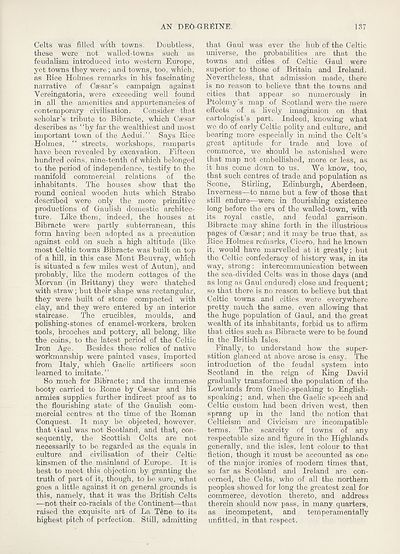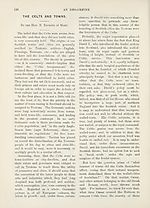An Comunn Gàidhealach Publications > Deo-gréine > Volume 17, October 1921 to September 1922
(145) Page 137
Download files
Complete book:
Individual page:
Thumbnail gallery: Grid view | List view

AN DEO-GREINE.
137
Celts was filled with towns. Doubtless,
these were not walled-towns such as
feudalism introduced into western Europe,
yet towns they were; and towns, too, which,
as Rice Holmes remarks in his fascinating
narrative of Caesar’s campaign against
Yereingatoria, were exceeding well found
in all the amenities and appurtenancies of
contemporary civilisation. Consider that
scholar’s tribute to Bibracte, which Caesar
describes as “by far the wealthiest and most
important town of the Aedui.” Says Rice
Holmes, “ streets, workshops, ramparts
have been revealed by excavation. Fifteen
hundred coins, nine-tenth of which belonged
to the period of independence, testify to the
manifold commercial relations of the
inhabitants. The houses show that the
round conical wooden huts which Strabo
described were only the more primitive
productions of Gaulish domestic architec¬
ture. Like them, indeed, the houses at
Bibracte were partly subterranean, this
form having been adopted as a precaution
against cold on such a high altitude (like
most Celtic towns Bibracte was built on top
of a hill, in this case Mont Beuvray, which
is situated a few miles west of Autun), and
probably, like the modern cottages of the
Morvan (in Brittany) they were thatched
with straw; but their shape was rectangular,
they were built of stone compacted with
clay, and they were entered by an interior
staircase. The crucibles, moulds, and
polishing-stones of enamel-workers, broken
tools, brooches and pottery, all belong, like
the coins, to the latest period of the Celtic
Iron Age. Besides these relics of native
workmanship were painted vases, imported
from Italy, which Gaelic artificers soon
learned to imitate.’’
So much for Bibracte; and the immense
booty carried to Rome by Caesar and his
armies supplies further indirect proof as to
the flourishing state of the Gaulish com¬
mercial centres at the time of the Roman
Conquest. It may be objected, however,
that Gaul was not Scotland, and that, con¬
sequently, the Scottish Celts are not
necessarily to be regarded as the equals in
culture and civilisation of their Celtic
kinsmen of the mainland of Europe. It is
best to meet this objection by granting the
truth of part of it, though, to be sure, what
goes a little against it on general grounds is
this, namely, that it was the British Celts
—not their co-racials of the Continent—that
raised the exquisite art of La T&ne to its
highest pitch of perfection. Still, admitting
that Gaul was ever the hub of the Celtic
universe, the probabilities are that the
towns and cities of Celtic Gaul were
superior to those of Britain and Ireland.
Nevertheless, that admission made, there
is no reason to believe that the towns and
cities that appear so numerously in
Ptolemy’s map of Scotland were the mere
effects of a lively imaginaion on that
cartologist’s part. Indeed, knowing what
we do of early Celtic polity and culture, and
bearing more especially in mind the Celt’s
great aptitude for trade and love of
commerce, we should be astonished were
that map not embellished, more or less, as
it has come down to us. We know, too,
that such centres of trade and population as
Scone, Stirling, Edinburgh, Aberdeen,
Inverness—to name but a few of those that
still endure—were in flourishing existence
long before the era of the walled-town, with
its royal castle, and feudal garrison.
Bibracte may shine forth in the illustrious
pages of Csesar; and it may be true that, as
Rice Holmes remarks, Cicero, had he known
it, would have marvelled at it greatly; but
the Celtic confederacy of history was, in its
way, strong : intercommunication between
the sea-divided Celts was in those days (and
as long as Gaul endured) close and frequent;
so that there is no reason to believe but that
Celtic towns and cities were everywhere
pretty much the same, even allowing that
the huge population of Gaul, and the great
wealth of its inhabitants, forbid us to affirm
that cities such as Bibracte were to be found
in the British Isles.
Finally, to understand how the super¬
stition glanced at above arose is easy. The
introduction of the feudal system into
Scotland in the reign of King David
gradually transformed the population of the
Lowlands from Gaelic-speaking to English-
speaking; and, when the Gaelic speech and
Celtic custom had been driven west, then
sprang up in the land the notion that
Celticism and Civicism are incompatible
terms. The scarcity of towns of any
respectable size and figure in the Highlands
generally, and the isles, lent colour to that
fiction, though it must be accounted as one
of the major ironies of modern times that,
so far as Scotland and Ireland are con¬
cerned, the Celts, who of all the northern
peoples showed for long the greatest zeal for
commerce, devotion thereto, and address
therein should now pass, in many quarters,
as incompetent, and temperamentally
unfitted, in that respect.
137
Celts was filled with towns. Doubtless,
these were not walled-towns such as
feudalism introduced into western Europe,
yet towns they were; and towns, too, which,
as Rice Holmes remarks in his fascinating
narrative of Caesar’s campaign against
Yereingatoria, were exceeding well found
in all the amenities and appurtenancies of
contemporary civilisation. Consider that
scholar’s tribute to Bibracte, which Caesar
describes as “by far the wealthiest and most
important town of the Aedui.” Says Rice
Holmes, “ streets, workshops, ramparts
have been revealed by excavation. Fifteen
hundred coins, nine-tenth of which belonged
to the period of independence, testify to the
manifold commercial relations of the
inhabitants. The houses show that the
round conical wooden huts which Strabo
described were only the more primitive
productions of Gaulish domestic architec¬
ture. Like them, indeed, the houses at
Bibracte were partly subterranean, this
form having been adopted as a precaution
against cold on such a high altitude (like
most Celtic towns Bibracte was built on top
of a hill, in this case Mont Beuvray, which
is situated a few miles west of Autun), and
probably, like the modern cottages of the
Morvan (in Brittany) they were thatched
with straw; but their shape was rectangular,
they were built of stone compacted with
clay, and they were entered by an interior
staircase. The crucibles, moulds, and
polishing-stones of enamel-workers, broken
tools, brooches and pottery, all belong, like
the coins, to the latest period of the Celtic
Iron Age. Besides these relics of native
workmanship were painted vases, imported
from Italy, which Gaelic artificers soon
learned to imitate.’’
So much for Bibracte; and the immense
booty carried to Rome by Caesar and his
armies supplies further indirect proof as to
the flourishing state of the Gaulish com¬
mercial centres at the time of the Roman
Conquest. It may be objected, however,
that Gaul was not Scotland, and that, con¬
sequently, the Scottish Celts are not
necessarily to be regarded as the equals in
culture and civilisation of their Celtic
kinsmen of the mainland of Europe. It is
best to meet this objection by granting the
truth of part of it, though, to be sure, what
goes a little against it on general grounds is
this, namely, that it was the British Celts
—not their co-racials of the Continent—that
raised the exquisite art of La T&ne to its
highest pitch of perfection. Still, admitting
that Gaul was ever the hub of the Celtic
universe, the probabilities are that the
towns and cities of Celtic Gaul were
superior to those of Britain and Ireland.
Nevertheless, that admission made, there
is no reason to believe that the towns and
cities that appear so numerously in
Ptolemy’s map of Scotland were the mere
effects of a lively imaginaion on that
cartologist’s part. Indeed, knowing what
we do of early Celtic polity and culture, and
bearing more especially in mind the Celt’s
great aptitude for trade and love of
commerce, we should be astonished were
that map not embellished, more or less, as
it has come down to us. We know, too,
that such centres of trade and population as
Scone, Stirling, Edinburgh, Aberdeen,
Inverness—to name but a few of those that
still endure—were in flourishing existence
long before the era of the walled-town, with
its royal castle, and feudal garrison.
Bibracte may shine forth in the illustrious
pages of Csesar; and it may be true that, as
Rice Holmes remarks, Cicero, had he known
it, would have marvelled at it greatly; but
the Celtic confederacy of history was, in its
way, strong : intercommunication between
the sea-divided Celts was in those days (and
as long as Gaul endured) close and frequent;
so that there is no reason to believe but that
Celtic towns and cities were everywhere
pretty much the same, even allowing that
the huge population of Gaul, and the great
wealth of its inhabitants, forbid us to affirm
that cities such as Bibracte were to be found
in the British Isles.
Finally, to understand how the super¬
stition glanced at above arose is easy. The
introduction of the feudal system into
Scotland in the reign of King David
gradually transformed the population of the
Lowlands from Gaelic-speaking to English-
speaking; and, when the Gaelic speech and
Celtic custom had been driven west, then
sprang up in the land the notion that
Celticism and Civicism are incompatible
terms. The scarcity of towns of any
respectable size and figure in the Highlands
generally, and the isles, lent colour to that
fiction, though it must be accounted as one
of the major ironies of modern times that,
so far as Scotland and Ireland are con¬
cerned, the Celts, who of all the northern
peoples showed for long the greatest zeal for
commerce, devotion thereto, and address
therein should now pass, in many quarters,
as incompetent, and temperamentally
unfitted, in that respect.
Set display mode to:
![]() Universal Viewer |
Universal Viewer | ![]() Mirador |
Large image | Transcription
Mirador |
Large image | Transcription
| An Comunn Gàidhealach > An Comunn Gàidhealach Publications > Deo-gréine > Volume 17, October 1921 to September 1922 > (145) Page 137 |
|---|
| Permanent URL | https://digital.nls.uk/127171713 |
|---|
| Description | Leabhar 17, Treasamh Mios an Fhoghair 1921 gu Dara Mìos an Fhoghair 1922 |
|---|---|
| Attribution and copyright: |
|
| Description | This contains items published by An Comunn, which are not specifically Mòd-related. It includes journals, annual reports and corporate documents, policy statements, educational resources and published plays and literature. It is arranged alphabetically by title. |
|---|
| Description | A collection of over 400 items published by An Comunn Gàidhealach, the organisation which promotes Gaelic language and culture and organises the Royal National Mòd. Dating from 1891 up to the present day, the collection includes journals and newspapers, annual reports, educational materials, national Mòd programmes, published Mòd literature and music. |
|---|---|
| Additional NLS resources: |
|

